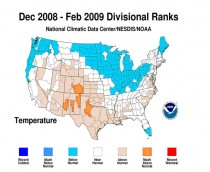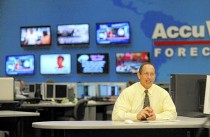
By Mackenzie Carpenter, Pittsburgh Post-Gazette
STATE COLLEGE—Summer is just so yesterday.
Or is it?
Today may be the first day of autumn, but Joe Bastardi, the exuberant, colorful, controversial Accuweather hurricane forecaster—indeed, the only meteorologist probably ever to appear on both Stephen Colbert’s and Bill O’Reilly’s shows—was hunched over three computer screens Tuesday shaking his head.
“I don’t think you’ll need your fall clothing in October, but you’re going to need it in November,” he said, noting that after Wednesday’s late-day storms cooled things off a bit, Friday’s temperatures in Pittsburgh would be 10 to 15 degrees above normal and will remain relatively mild through the end of next month—when it will suddenly get cold.
But what was really consuming Mr. Bastardi’s attention at Accuweather’s headquarters wasn’t the balmy weather system draping itself over the Northeast and Mid-Atlantic for the next six weeks or so, but rather two blobs at the bottom of his screen.
“That’s Lisa, she’s not a worry to us,” he said, pointing to a hurricane in the eastern Atlantic. “And that,” he said, pointing to a fuzzy area near South America, his voice lowering to a whisper, “is not quite alive yet, but it’s going to be Matthew. By this time next week you could have two more going at the same time.”
Lisa and Matthew may either signal the beginning of the end of the hurricane season, which officially started June 1 and ends Nov. 30—or merely the end of the beginning.
Indeed, at State College-based Accuweather, one of the two big for-profit weather services (The Weather Channel, a cable channel with an online site, is the other), that means a big, sexy, if initially somewhat incomprehensible headline—“Get Ready for Troptober”—on a Tuesday afternoon press release.
“AccuWeather.com Hurricane Expert Joe Bastardi remains very concerned that the raging La Nina and its associated cool waters in the tropical Pacific have created a tremendous imbalance” leading to a very tropical October in the southeastern U.S. (Troptober, get it?) and “a barrage of tropical cyclones appearing to form in succession over the Caribbean and the southwestern Atlantic during the last few days of September through the first part in October.”
Which is to say, Katy bar the door, at least if you live anywhere between Louisiana and the Carolinas—and Pittsburghers should pay attention, too, since any storm coming through the Gulf of Mexico could end up as remnants here.
In this busiest of seasons for hurricane forecasters, Mr. Bastardi, who says he got three hours of sleep the night before, has a lot riding on whether this year’s count is correct. In February, he forecast 16 to 18 storms, including what he called 7 “impact events” (i.e. those with winds of 40 miles an hour that impact the U.S., either brushing or hitting the coast directly). In June, he upped that figure to 18 to 21 storms, with eight impact events, four or five of which would be hurricanes. Of those hurricanes, he added, two would be major, with winds of 110 miles an hour or more.
So far, he’s up to five impact events but only one hurricane affecting the U.S.—Earl. It’s still been a year for the history books, though. For the first time in 84 years, two category 4 storms—Igor and Julia—reached that intensity in the Atlantic, on the same day, even if they never did reach the U.S.
Mr. Bastardi, chief hurricane and long range forecaster—and, at 55, a national bodybuilding competitor in his spare time—calls himself “a warrior for the weather.” He hasn’t always been right—after five nearly flawless years in a row, he stumbled a bit in 2007 when he got the total number of hurricanes correct but predicted that Florida would be “a bull’s eye,” when it wasn’t.
But 2008 and 2009 were on target, which is important for Mr. Bastardi’s private clients around the world, mostly energy traders, retailers, agricultural interests, as well as readers of Accuweather.com’s professional and free sites.
This year, the weather patterns are “just like 1964. And 1950,” said Mr. Bastardi, who relies not just on computer modeling but climate history to inform his forecasts, noting that the Atlantic has been in a warm phase since 1995, when the latest active-hurricane era began, and will start entering a cooling down period in about 10 years.
“The greatest thing about Joe is that he loves the weather,” said William Gray, the 80-year old dean of hurricane scientists at Colorado State University, who issues his own forecasts in December and also predicted a busier than usual season.
Which brings us to a slightly sticky subject: Dr. Gray, like Mr. Bastardi, firmly believes that human-generated global warming isn’t happening but is just part of a natural phenomenon of long-term warming and cooling trends.
Both have received considerable flak for this—New Yorker writer Elizabeth Kolbert called Mr. Bastardi’s position “ridiculous” in a column—but Mr. Bastardi loves a good argument, so he appeared on Bill O’Reilly’s Fox News program last year to debate the issue with Bill Nye, “The Science Guy.” Then, in April, he faced off on Comedy Central’s “The Colbert Report” against Brenda Ekwurzel of the Union of Concerned Scientists.
“He’s among a minority of meteorologists, mostly on television, who say these things and who don’t have expertise in what’s happening with our climate from a long-range perspective,” said Aaron Huertas, a spokesman for the Union of Concerned Scientists. “It’s about as valid as a climate scientist criticizing Mr. Bastardi’s annual hurricane predictions.”
Mr. Bastardi is unapologetic and, more than that, regards Dr. Gray as something of a father figure—next to his own father, who was also a meteorologist. After telling Dr. Gray he’d been conceived in October of 1954 during Hurricane Hazel, he says the senior hurricane scientist fixed him with a glare.
“Think Christopher Lloyd, the mad scientist in ‘Back to the Future,’ “ Mr. Bastardi said. “Dr. Gray just looked at me and said, ‘That’s remarkable,’ and went on to say that he’d been in the hurricane forecast center in Washington, D.C., the night Hazel hit, ‘and the forecaster watching the storm had a coronary and died. That means HIS spirit must have entered your body!’ “
Mr. Bastardi laughs at the memory, then turns serious.
“My mother called me in tears once,” he said, after she’d read the comments section of The Huffington Post during the global warming controversy when some poster called him “the meteorological equivalent of Glenn Beck ... while some facets of what he says might be true, Bastardi has a horrific record of crying wolf.”
“I told her, ‘Mom, you shouldn’t read that stuff.’ “
Still, in the Sept. 21 column “Do I even want to be right?” published on Statecollege.com, Mr. Bastardi described how conflicted he’s felt in the past for being right, because “If I’m right, it means misery, pure and simple.” But when “your personality accepts nothing less than winning,” being wrong is painful, too, he said.
Still, he takes comfort from words spoken by his Accuweather boss, Joel Myers, made during one of many impassioned arguments over weather they’d had over the years.
“He said, ‘You know you’re among the best when you start getting judged by your worst day.’ “ See post here. See six prominent climatologists who agree with Joe’s take on climate change here.
-----------
More on Warm Summer in Central and Eastern United States
By Joseph D’Aleo
NCDC reported that the summer was the fourth warmest for the United States according to NOAA NCDC. Although the graph of the June through August period from NCDC suggests it was the 9th warmest.

Enlarged here.
Before 2007 in version 1 of USHCN there was an urban adjustment that reduced temperatures in urban areas according to the population. That was removed in 2007 which resulted in a cooling of the temperatures before 1980 and a warming of the recent decades.
However there is no doubt it was a warm summer in the east and central. This was expected as an El Nino winter that gives way to a moderate La Nina summer is typically hot in the central and east (1966, 1988, 1995 and 1999 are some examples). Most forecasters saw this coming. La Nina will mean next summer will be cooler more like 2008 or 2009. (Note: Dr. Madhav Khandekar has shown in this analysis the same rapid transition of El Nino to La Nina leads to heavier monsoon like rains and flooding in India and Pakistan.
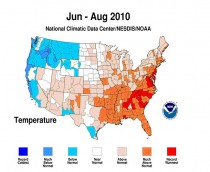
Enlarged here.
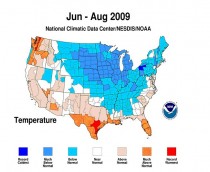
Summer 2009 was 0.5F below normal. Enlarged here.

Summer 2008 was 0.4F above for the US as a whole though cold in the central. Enlarged here.
The average for the summer for the United States was 2.2F above normal this year that matched the amount the winter temperatures were BELOW normal this past winter for the United States.
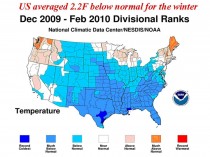
Enlarged here.
This winter will be more like that of 2007/08 or 2008/09. The La Nina will mean next summer will be cooler more like 2008 or 2009. (PDF)
Also note what we showed after last winter in this story by Steve Goddard on WUWT how Rutgers Snow Lab Northern Hemisphere snow cover for the winter has 3 of the top 4 winters this past decade. Steve with tongue frozen in cheek correctly points out: “During the 1960s and 1970s, extensive snow cover was caused by cold temperatures - but since global climate disruption kicked in, snow is now caused by heat. Global climate disruption has apparently changed the fundamental properties of water.”
UPDATE: Listen to a PODCAST that addresses the extreme temperature issues among others. See also many other Podcasts from James Taylor and the Heartland Environmental and Climate News site.





